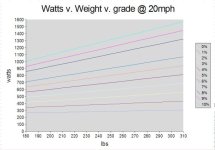The Mighty Volt
1 MW
Hi,
I have been mulling over getting a rear hub motor for my MTB.
Given that I am already equipped with a front hub with 700 watt rating, I found myself asking just what do I want the rear hub to do.
The answer: an auxiliary, workhorse wheel designed to aid during severe uphill treks and on flat runs with a 50l backpack filled with scrap metal. In other words- donkey work.
How then do we distinguish between watts and torque?
Does a 1000w motor necessarily have more torque than a 700 watt motor?
Is 700 Watts of Cammy power incapable of performing more work than 500w of Golden Motor?
Horsepower is often measured in Kilowatts, and we know there is a difference between Torque and Horsepower.
Or does it all depend on the voltage of the motor combined with the wattage rating of the motor?
Does a 48v 10Ah Battery +500w Hub perform more or less work than a 36v 20Ah battery+ 700w Hub, with all things being considered equal?
Thanks for your considered opinions.
I have been mulling over getting a rear hub motor for my MTB.
Given that I am already equipped with a front hub with 700 watt rating, I found myself asking just what do I want the rear hub to do.
The answer: an auxiliary, workhorse wheel designed to aid during severe uphill treks and on flat runs with a 50l backpack filled with scrap metal. In other words- donkey work.
How then do we distinguish between watts and torque?
Does a 1000w motor necessarily have more torque than a 700 watt motor?
Is 700 Watts of Cammy power incapable of performing more work than 500w of Golden Motor?
Horsepower is often measured in Kilowatts, and we know there is a difference between Torque and Horsepower.
Or does it all depend on the voltage of the motor combined with the wattage rating of the motor?
Does a 48v 10Ah Battery +500w Hub perform more or less work than a 36v 20Ah battery+ 700w Hub, with all things being considered equal?
Thanks for your considered opinions.


